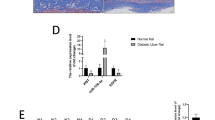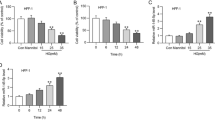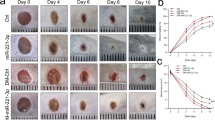Abstract
Traditional Chinese medicine has been used to treat diabetic foot ulcer (DFU) for a long time. However, the underlying mechanism of Radix arnebiae seu lithospermi ointment (RAS-ointment) has not been revealed. Effects of RAS-ointment treatment were observed in DFU patients. The endogenous competitive RNA mechanism was constructed based on micro-array sequencing and bioinformatics analysis. RT-PCR was used to detected the expression of genes in DFU ulcerated skins and non-ulcerated skins. Dual luciferase and RT-PCR experiments were used to investigate the endogenous competitive RNA mechanism. Based on micro-array sequencing and bioinformatics analysis, we found that SNHG12/NFYC-AS1, hsa-miR-199a-5p and S100A8/S100A7/XDH might form an endogenous competitive RNA mechanism. RT-PCR assay shown that SNHG12, NFYC-AS1, S100A8, S100A7 and XDH were significantly up-regulated, while hsa-miR-199a-5p was significantly down-regulated in DFU ulcerated skins (N = 10) compared with non-ulcerated skins (N = 10). Dual luciferase and RT-PCR experiments showed that SNHG12 or NFYC-AS1 up-regulated the expression of S100A8, S100A7 and XDH by inhibiting hsa-miR-199a-5p in a direct binding way. After 35 days of RAS-ointment treatment, the wound healing of DFU patients was substantially improved and the expression of S100A7 and XDH were reduced expression in DFU patients. In addition, the monomer composition of RAS-ointment, 49070_FLUKA or auraptenol inhibited the expression of S100A7 and XDH in Te317.sk cells. In conclusion, RAS-ointment may be used as an adjunctive therapy for DFU patients.






Similar content being viewed by others
Data Availability
The datasets during and/or analyzed during the current study are available from the corresponding author on reasonable request.
References
Everett, E., & Mathioudakis, N. (2018). Update on management of diabetic foot ulcers. Annals of the New York Academy of Sciences, 1411, 153–165.
Armstrong, D. G., Boulton, A. J. M., & Bus, S. A. (2017). Diabetic foot ulcers and their recurrence. The New England Journal of Medicine, 376, 2367–2375.
McGloin, H., Devane, D., McIntosh, C. D., et al. (2021). Psychological interventions for treating foot ulcers, and preventing their recurrence, in people with diabetes. The Cochrane Database of Systematic Reviews, 2, CD012835.
Yan, C., Chen, J., Yang, X., et al. (2021). Emerging roles of long non-coding RNAs in diabetic foot ulcers. Diabetes, Metabolic Syndrome and Obesity: Targets and Therapy, 14, 2549–2560.
Lekka, E., & Hall, J. (2018). Noncoding RNAs in disease. FEBS Letters, 592, 2884–2900.
Ala, U. (2020). Competing endogenous RNAs, non-coding RNAs and diseases: An intertwined story. Cells, 9, 1574.
Li, B., Zhou, Y., Chen, J., et al. (2021). Long noncoding RNA H19 acts as a miR-29b sponge to promote wound healing in diabetic foot ulcer. FASEB Journal: Official Publication of the Federation of American Societies for Experimental Biology, 35, e20526.
Li, B., Luan, S., Chen, J., et al. (2020). The MSC-derived exosomal lncRNA H19 promotes wound healing in diabetic foot ulcers by upregulating PTEN via microRNA-152-3p. Molecular Therapy Nucleic Acids, 19, 814–826.
Zhu, L., Zhong, Q., Yang, T., et al. (2019). Improved therapeutic effects on diabetic foot by human mesenchymal stem cells expressing MALAT1 as a sponge for microRNA-205-5p. Aging, 11, 12236–12245.
Wang, J., Wong, Y. K., & Liao, F. (2018). What has traditional Chinese medicine delivered for modern medicine? Expert Reviews in Molecular Medicine, 20, e4.
Guo, C., He, J., Song, X., et al. (2019). Pharmacological properties and derivatives of shikonin-A review in recent years. Pharmacological Research, 149, 104463.
Zhu, L., Ma, S., Li, K., et al. (2022). Systematic screening of chemical constituents in the traditional Chinese medicine Arnebiae Radix by UHPLC-Q-exactive orbitrap mass spectrometry. Molecules, 27, 2631.
Hsiao, C. Y., Hung, C. Y., Tsai, T. H., et al. (2012). A study of the wound healing mechanism of a traditional Chinese medicine, angelica sinensis, using a proteomic approach. Evidence-Based Complementary and Alternative Medicine: ECAM, 2012, 467531.
Guo, J., Hu, Z., Yan, F., et al. (2020). Angelica dahurica promoted angiogenesis and accelerated wound healing in db/db mice via the HIF-1alpha/PDGF-beta signaling pathway. Free Radical Biology & Medicine, 160, 447–457.
Chen, Y. H., Chen, W. C., Tsai, K. S., et al. (2020). Efficacy of frankincense and Myrrha in treatment of acute interstitial cystitis/painful bladder syndrome. Chinese Journal of Integrative Medicine, 26, 519–526.
Lu, T. X., & Rothenberg, M. E. (2018). MicroRNA. The Journal of Allergy and Clinical Immunology, 141, 1202–1207.
Long, J., Bai, Y., Yang, X., et al. (2019). Construction and comprehensive analysis of a ceRNA network to reveal potential prognostic biomarkers for hepatocellular carcinoma. Cancer Cell International, 19, 90.
Lim, J. Z., Ng, N. S., & Thomas, C. (2017). Prevention and treatment of diabetic foot ulcers. Journal of the Royal Society of Medicine, 110, 104–109.
Donato, R., Cannon, B. R., Sorci, G., et al. (2013). Functions of S100 proteins. Current Molecular Medicine, 13, 24–57.
Singh, K., Agrawal, N. K., Gupta, S. K., et al. (2016). Increased expression of TLR9 associated with pro-inflammatory S100A8 and IL-8 in diabetic wounds could lead to unresolved inflammation in type 2 diabetes mellitus (T2DM) cases with impaired wound healing. Journal of Diabetes and Its Complications, 30, 99–108.
Rangaraj, A., Ye, L., Sanders, A. J., et al. (2017). Molecular and cellular impact of Psoriasin (S100A7) on the healing of human wounds. Experimental and Therapeutic Medicine, 13, 2151–2160.
Kelley, E. E. (2015). Dispelling dogma and misconceptions regarding the most pharmacologically targetable source of reactive species in inflammatory disease, xanthine oxidoreductase. Archives of Toxicology, 89, 1193–1207.
Liu, N., Xu, H., Sun, Q., et al. (2021). The role of oxidative stress in hyperuricemia and xanthine oxidoreductase (XOR) inhibitors. Oxidative Medicine and Cellular Longevity, 2021, 1470380.
Weinstein, A. L., Lalezarzadeh, F. D., Soares, M. A., et al. (2015). Normalizing dysfunctional purine metabolism accelerates diabetic wound healing. Wound Repair and Regeneration: Official Publication of the Wound Healing Society [and] the European Tissue Repair Society, 23, 14–21.
Trostrup, H., Holstein, P., Christophersen, L., et al. (2016). S100A8/A9 is an important host defence mediator in neuropathic foot ulcers in patients with type 2 diabetes mellitus. Archives of Dermatological Research, 308, 347–355.
Ban, E., Jeong, S., Park, M., et al. (2020). Accelerated wound healing in diabetic mice by miRNA-497 and its anti-inflammatory activity. Biomedicine & Pharmacotherapy, 121, 109613.
Lin, C. J., Lan, Y. M., Ou, M. Q., et al. (2019). Expression of miR-217 and HIF-1alpha/VEGF pathway in patients with diabetic foot ulcer and its effect on angiogenesis of diabetic foot ulcer rats. Journal of Endocrinological Investigation, 42, 1307–1317.
Xu, Y., Yu, T., He, L., et al. (2020). Inhibition of miRNA-152-3p enhances diabetic wound repair via upregulation of PTEN. Aging, 12, 14978–14989.
Wang, H., Wang, X., Liu, X., et al. (2022). miR-199a-5p plays a pivotal role on wound healing via suppressing VEGFA and ROCK1 in diabetic ulcer foot. Oxidative Medicine and Cellular Longevity, 2022, 4791059.
Yu, Y., Zhou, H., Xiong, Y., et al. (2020). Exosomal miR-199a-5p derived from endothelial cells attenuates apoptosis and inflammation in neural cells by inhibiting endoplasmic reticulum stress. Brain Research, 1726, 146515.
Wu, M. H., Tsai, C. H., Huang, Y. L., et al. (2018). Visfatin promotes IL-6 and TNF-alpha production in human synovial fibroblasts by repressing miR-199a-5p through ERK, p38 and JNK signaling pathways. International Journal of Molecular Sciences, 19, 190.
Gu, X., Weng, R., Hou, J., et al. (2022). Endothelial miR-199a-3p regulating cell adhesion molecules by targeting mTOR signaling during inflammation. European Journal of Pharmacology, 925, 174984.
Louiselle, A. E., Niemiec, S. M., Zgheib, C., et al. (2021). Macrophage polarization and diabetic wound healing. Translational Research: The Journal of Laboratory and Clinical Medicine, 236, 109–116.
He, G. Y., Zhao, C. H., Wu, D. G., et al. (2020). S100A8 promotes inflammation via toll-like receptor 4 after experimental traumatic brain injury. Frontiers in Neuroscience, 14, 616559.
Sun, Q., Cao, Y., Lan, Y., et al. (2021). S100A7 promotes the development of human endometriosis by activating NF-kappaB signaling pathway in endometrial stromal cells. Cell biology International, 45, 1327–1335.
Kushiyama, A., Tanaka, K., Hara, S., et al. (2014). Linking uric acid metabolism to diabetic complications. World Journal of Diabetes, 5, 787–795.
Peng, W. X., He, P. X., Liu, L. J., et al. (2021). LncRNA GAS5 activates the HIF1A/VEGF pathway by binding to TAF15 to promote wound healing in diabetic foot ulcers. Laboratory Investigation, 101, 1071–1083.
Li, B., Zhou, Y., Chen, J., et al. (2020). Long non-coding RNA H19 contributes to wound healing of diabetic foot ulcer. Journal of Molecular Endocrinology. https://doi.org/10.1530/JME-19-0242
Hu, M., Wu, Y., Yang, C., et al. (2020). Novel long noncoding RNA lnc-URIDS delays diabetic wound healing by targeting Plod1. Diabetes, 69, 2144–2156.
Sun, Y., Zhao, J. T., Chi, B. J., et al. (2020). Long noncoding RNA SNHG12 promotes vascular smooth muscle cell proliferation and migration via regulating miR-199a-5p/HIF-1alpha. Cell Biology International, 44, 1714–1726.
Zhang, L., Li, B., Zhang, D., et al. (2022). lncRNA SNHG12 inhibition based on microsystem cell imaging technology protects the endothelium from LPS-induced inflammation by inhibiting the expression of mir-140-3p target gene fndc5. Contrast Media & Molecular Imaging, 2022, 1681864.
Yang, X., Chen, H., Zheng, H., et al. (2022). LncRNA SNHG12 promotes osteoarthritis progression through targeted down-regulation of miR-16-5p. Clinical Laboratory. https://doi.org/10.7754/Clin.Lab.2021.210402
Acknowledgements
Not applicable.
Funding
This study was supported by Special medical innovation research project of “scientific and technological innovation action plan” of Shanghai Science and Technology Commission in 2022 Clinical evaluation of traditional Chinese medicine multiphase therapy for diabetes foot ulcer No. 22y11922600.
Author information
Authors and Affiliations
Corresponding author
Ethics declarations
Conflict of interest
The authors declare that they have no competing interests.
Consent for publication
Not applicable.
Ethical Approval
All experiments obtained written informed consent from participants. All experiments were approved by the ethics Committee of Shuguang Hospital affiliated to Shanghai University of Chinese Medicine.
Additional information
Publisher's Note
Springer Nature remains neutral with regard to jurisdictional claims in published maps and institutional affiliations.
Rights and permissions
Springer Nature or its licensor (e.g. a society or other partner) holds exclusive rights to this article under a publishing agreement with the author(s) or other rightsholder(s); author self-archiving of the accepted manuscript version of this article is solely governed by the terms of such publishing agreement and applicable law.
About this article
Cite this article
Shaorong, Z., Xiaodong, L., Qiong, P. et al. SNHG12/NFYC-AS1 Acted as the Sponge for hsa-miR-199a-5p to Promote the Expression of S100A8/S100A7/XDH and was Involved in the Progression of Diabetic Foot Ulcers. Mol Biotechnol 65, 2038–2048 (2023). https://doi.org/10.1007/s12033-023-00692-4
Accepted:
Published:
Issue Date:
DOI: https://doi.org/10.1007/s12033-023-00692-4




